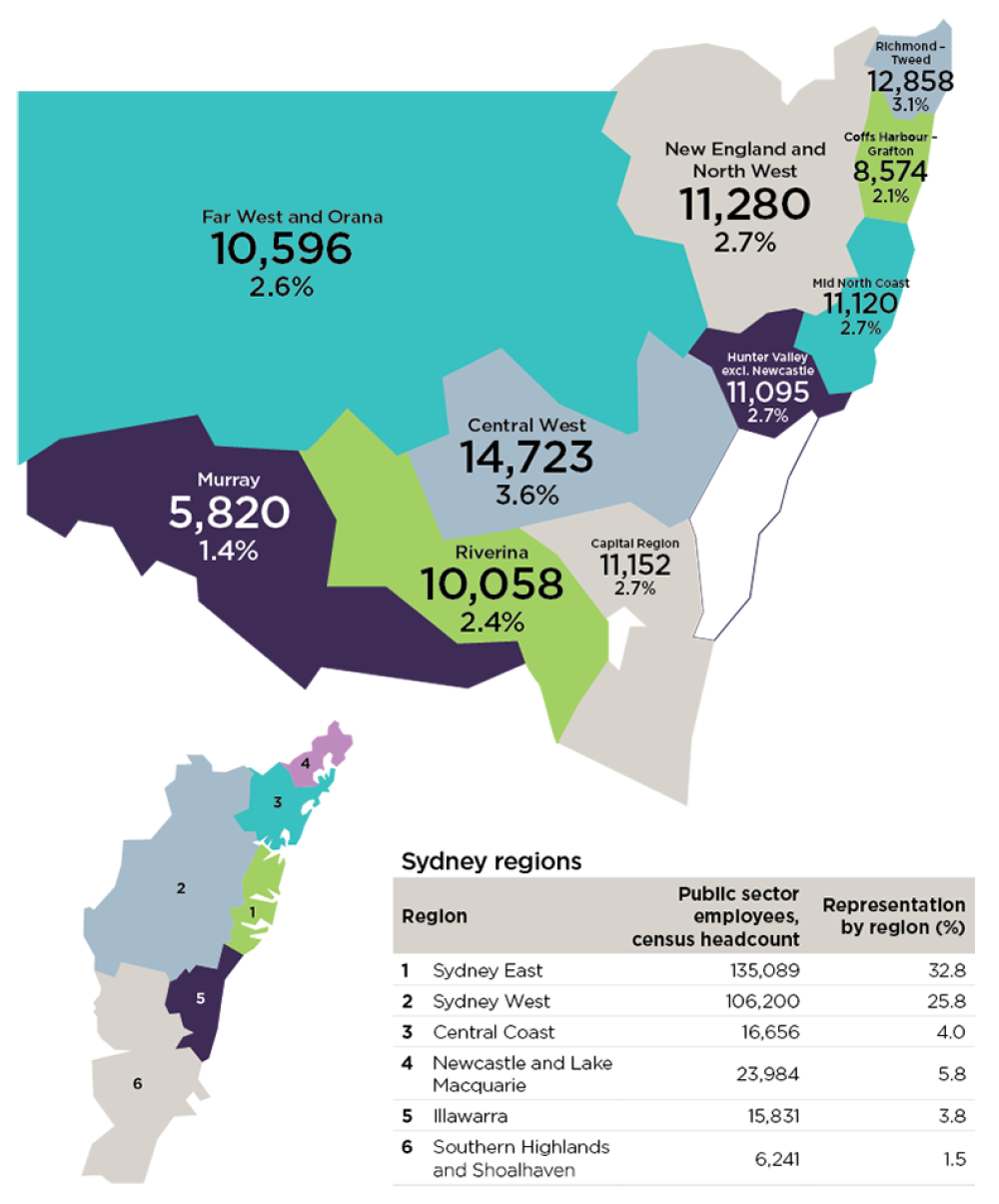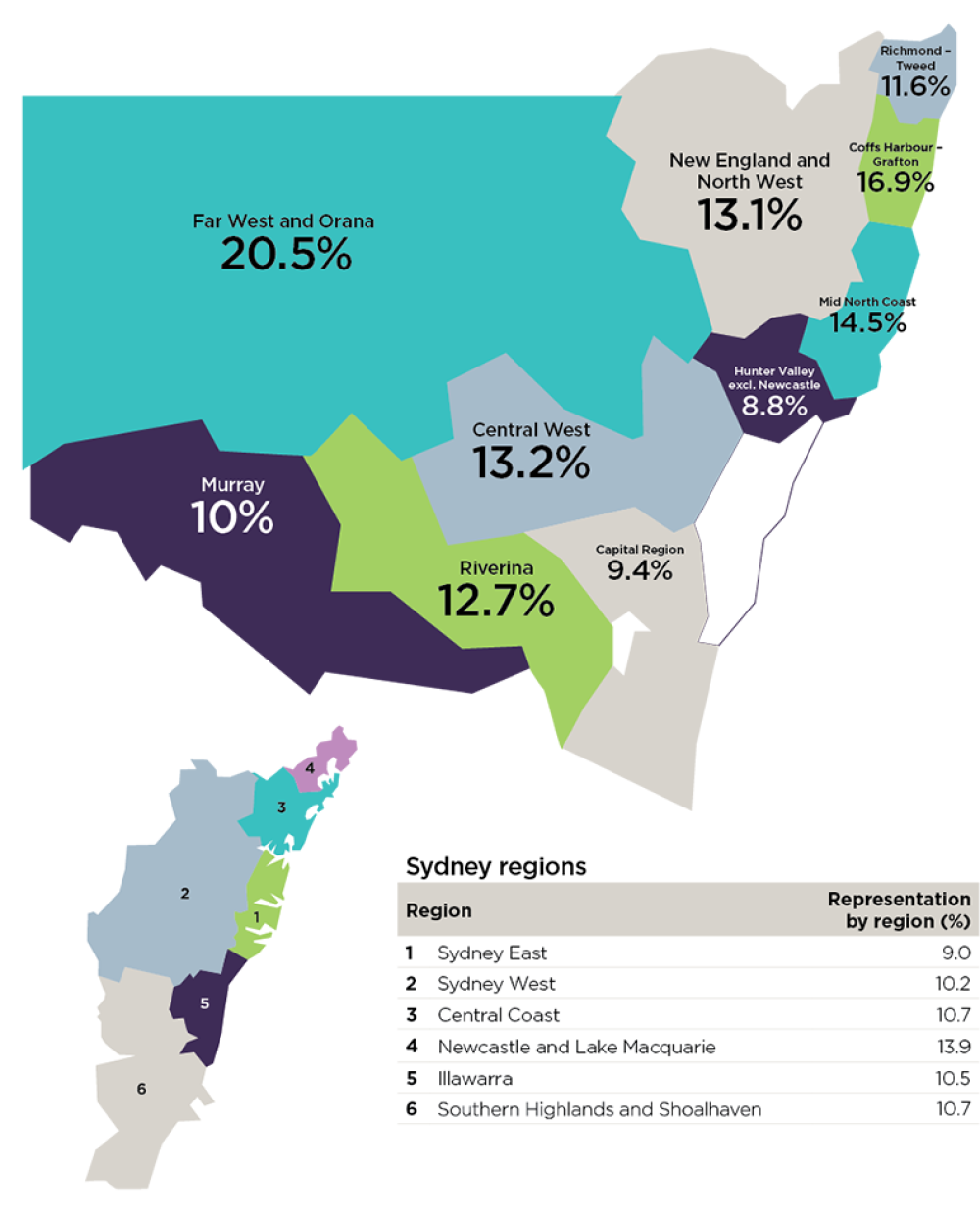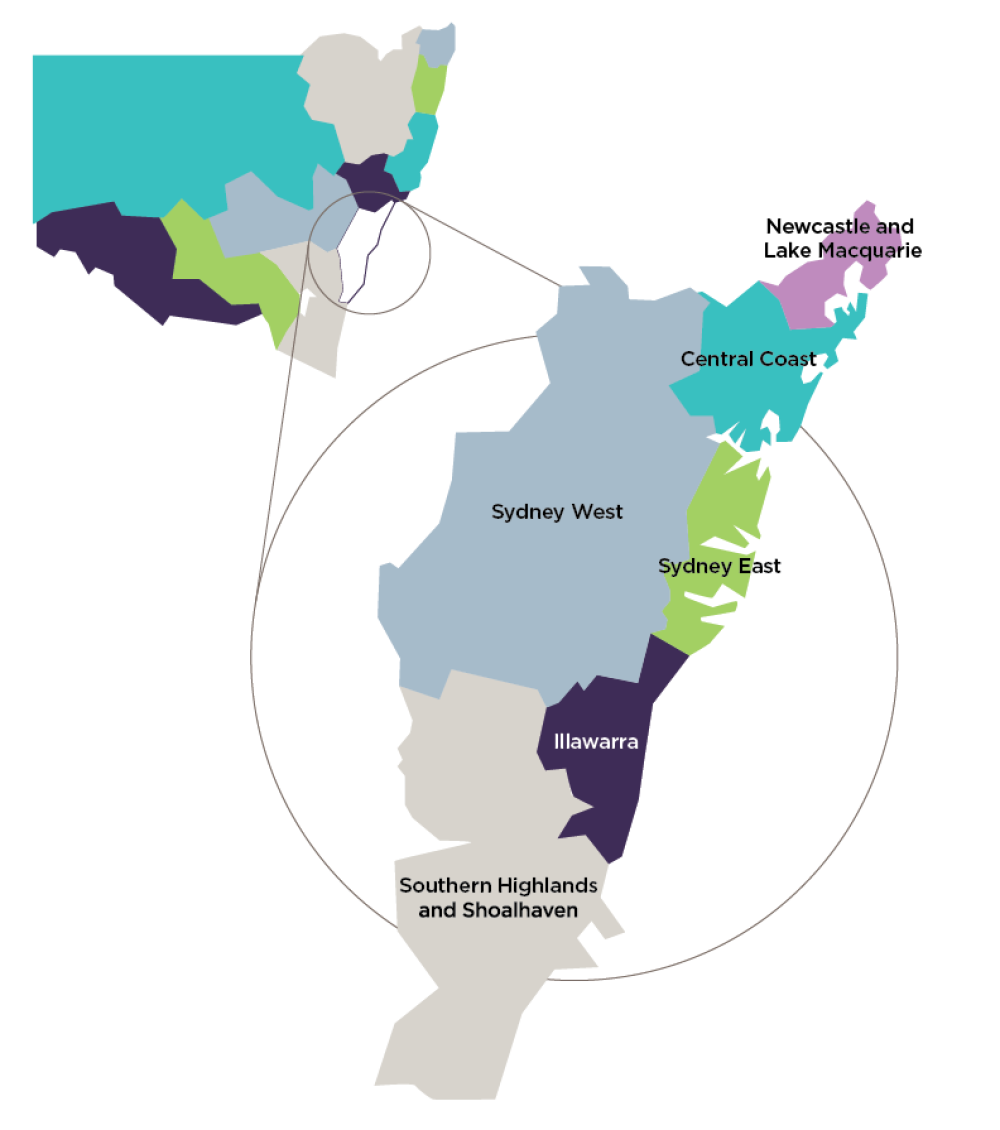The NSW public sector (which is the largest employer in Australia) accounts for more than 10% of employment in the state. As such, it has a big impact on the NSW workforce. While the majority of roles are in metropolitan areas, the public sector employs many people in regional areas and accounts for a significant proportion of all employment in regional NSW.1
Regional analysis in this report is based on employees’ normal stated work locations, as submitted in the Workforce Profile data by departments and agencies. This analysis does not reflect work‑from‑home arrangements, which were part of the response to the COVID-19 pandemic.
In 2020, 58.7% of NSW public sector employees worked in Sydney (Sydney East and Sydney West combined), with the remaining 41.3% spread across the rest of NSW (see Figure 11.1). The distribution of employees between Sydney and regional areas2 marginally favoured the latter when compared to the geographical distribution of the resident population of NSW, with an estimated 38.6% of people in NSW living in regional areas.
Figure 11.1: NSW public sector employees by region, census headcount, 2020

| Region | Public sector employees, census headcount | Representation by region (%) |
|---|---|---|
| Hunter Valley excl. Newcastle | 11,095 | 2.7 |
| Mid North Coast | 11,120 | 2.7 |
| New England and North West | 11,280 | 2.7 |
| Far West and Orana | 10,596 | 2.6 |
| Coffs Harbour - Grafton | 8,574 | 2.1 |
| Richmond - Tweed | 12,858 | 3.1 |
| Capital Region | 11,152 | 2.7 |
| Riverina | 10,058 | 2.4 |
| Murray | 5,820 | 1.4 |
| Central West | 14,723 | 3.6 |
Sydney regions
| Region | Public sector employees, census headcount | Representation by region (%) |
|---|---|---|
| Sydney East | 135,089 | 32.8 |
| Sydney West | 106,200 | 25.8 |
| Central Coast | 16,656 | 4.0 |
| Newcastle and Lake Macquarie | 23,984 | 5.8 |
| Illawarra | 15,831 | 3.8 |
| Southern Highlands and Shoalhaven | 6,241 | 1.5 |
Regional profiles
Key statistics for each region are displayed in Table 11.1, and distribution of the census period FTE by region and service is shown in Table 11.2. Table 11.1 compares 2020 with 2018 (rather than 2019) as the 2019 location data has been confirmed as low quality.3
Table 11.1: Key statistics by region, 20204
| Work region | Estimated resident population | Census period FTE 2018 | Census period FTE 2020 | Change census period FTE 2018 to 2020 (%) | Median age (years) | Median salary non-casual ($) | Median tenure non casual (years in agency) | Part-time non-casual (%) |
|---|---|---|---|---|---|---|---|---|
| Capital Region | 229,910 | 8,429 | 9,082 | 3.7 | 47 | $86,648 | 9.4 | 33.7 |
| Central Coast | 344,016 | 12,833 | 13,715 | 3.3 | 44 | $88,853 | 9.4 | 33.0 |
| Central West | 213,384 | 11,352 | 12,243 | 3.8 | 45 | $85,488 | 9.1 | 30.1 |
| Coffs Harbour – Grafton | 141,986 | 6,481 | 6,966 | 3.6 | 47 | $89,793 | 9.6 | 36.2 |
| Far West and Orana | 116,962 | 8,476 | 8,968 | 2.8 | 43 | $80,795 | 7.9 | 26.4 |
| Hunter Valley excl. Newcastle | 280,588 | 8,584 | 9,140 | 3.1 | 44 | $85,214 | 9.4 | 32.9 |
| Illawarra | 314,618 | 12,119 | 12,914 | 3.2 | 45 | $90,123 | 9.8 | 32.1 |
| Mid North Coast | 222,700 | 8,730 | 9,285 | 3.1 | 47 | $89,824 | 10.3 | 34.0 |
| Murray | 120,906 | 4,345 | 4,581 | 2.6 | 46 | $86,564 | 8.9 | 38.8 |
| New England and North West | 187,071 | 8,737 | 9,339 | 3.3 | 45 | $85,214 | 8.8 | 33.9 |
| Newcastle and Lake Macquarie | 378,683 | 18,667 | 19,633 | 2.5 | 44 | $90,123 | 9.4 | 34.9 |
| Richmond – Tweed | 252,650 | 9,526 | 10,214 | 3.5 | 47 | $90,123 | 10.1 | 41.6 |
| Riverina | 161,595 | 7,734 | 8,337 | 3.8 | 44 | $85,214 | 8.4 | 32.4 |
| Southern Highlands and Shoalhaven | 156,601 | 4,659 | 5,080 | 4.3 | 46 | $85,214 | 9.4 | 35.6 |
| Sydney East | 2,764,545 | 111,564 | 116,053 | 2.0 | 43 | $93,112 | 7.1 | 21.3 |
| Sydney West | 2,203,602 | 81,647 | 91,549 | 5.7 | 42 | $90,123 | 8.4 | 22.1 |
In 2020, regional NSW accounted for 40.2% of FTE, while Sydney East and Sydney West together accounted for 59.8% (see Table 11.2). In line with previous years, the highest proportion of employees in the government sector working in regional areas were in the Teaching Service (44.1%) and the NSW Health Service (42.5%), followed by other Crown services (39.0%), the Public Service (36.5%), the NSW Police Force (35.5%) and the Transport Service (22.1%).
Table 11.2: Census period FTE by service and region, 2020
| Work region | Public Service | NSW Health Service | NSW Police Force | Teaching Service | Transport Service | Other Crown services | State owned corporations | External to government sector |
|---|---|---|---|---|---|---|---|---|
| Capital region | 1,767 | 3,003 | 678 | 2,171 | 193 | 922 | 348 | 0 |
| Central Coast | 2,184 | 6,102 | 762 | 3,071 | 129 | 1,467 | 0 | 0 |
| Central West | 3,107 | 4,050 | 575 | 2,370 | 203 | 1,530 | 407 | 0 |
| Coffs Harbour - Grafton | 1,189 | 2,526 | 286 | 1,435 | 416 | 829 | 285 | 0 |
| Far West and Orana | 2,111 | 2,825 | 559 | 1,737 | 253 | 1,099 | 385 | 0 |
| Hunter Valley excl. Newcastle | 2,442 | 2,121 | 495 | 2,644 | 54 | 1,241 | 144 | 0 |
| Illawarra | 1,576 | 5,326 | 647 | 2,913 | 437 | 1,930 | 85 | 0 |
| Mid North Coast | 1,162 | 3,172 | 385 | 2,123 | 70 | 1,325 | 1,048 | 1 |
| Murray | 614 | 1,541 | 291 | 1,158 | 107 | 647 | 224 | 0 |
| New England and North West | 1,565 | 3,149 | 561 | 2,210 | 172 | 1,314 | 367 | 1 |
| Newcastle and Lake Macquarie | 2,945 | 9,011 | 780 | 3,591 | 533 | 2,285 | 487 | 0 |
| Richmond - Tweed | 1,092 | 4,614 | 556 | 2,324 | 107 | 1,268 | 254 | 0 |
| Riverina | 1,350 | 3,056 | 387 | 1,779 | 302 | 1,085 | 377 | 0 |
| Southern Highlands and Shoalhaven | 969 | 1,707 | 245 | 1,437 | 40 | 664 | 18 | 0 |
| Sydney East | 24,529 | 39,014 | 6,632 | 18,369 | 8,677 | 16,577 | 1,261 | 992 |
| Sydney West | 17,285 | 31,658 | 6,458 | 20,878 | 1,945 | 10,959 | 2,364 | 2 |
NSW public sector relative to the NSW workforce
The NSW public sector accounted for 10.4% of the 3,947,132 people employed in NSW at June 2020.5 This is a notable increase from 9.8% last year, and is likely a result of a reduction in the number of employed persons in NSW due to the pandemic (204,830 fewer employed persons).
Analysis of the geographic distribution of NSW public sector employees (including casuals) relative to the overall workforce6 shows where government employment contributed the most to local and regional economies. Figure 11.2 shows the percentage of employed persons who were NSW public sector employees in each region in 2020. Most regions had between 10% and 15% of their employed persons working for the NSW public sector, with notable exceptions being Far West and Orana (20.5%) and Coffs Harbour – Grafton (16.9%).
Figure 11.3: Public sector employees as a proportion of NSW employed persons by region, 2020

| Work region | % |
|---|---|
| Hunter Valley excl. Newcastle | 8.8 |
| Sydney East | 9.0 |
| Capital Region | 9.4 |
| Murray | 10.0 |
| Sydney West | 10.2 |
| Illawarra | 10.5 |
| Southern Highlands and Shoalhaven | 10.7 |
| Central Coast | 10.7 |
| Richmond - Tweed | 11.6 |
| Riverina | 12.7 |
| New England and North West | 13.1 |
| Central West | 13.2 |
| Newcastle and Lake Macquarie | 13.9 |
| Mid North Coast | 14.5 |
| Coffs Harbour - Grafton | 16.9 |
| Far West and Orana | 20.5 |
Employees
The percentage of NSW public sector employees whose normal work location is in a different region to their home location varies across regions (see Figure 11.4). In the Hunter Valley (excluding Newcastle), Central Coast, Illawarra, and Southern Highlands and Shoalhaven regions, between 30% and 40% of public sector employees generally work in a different region to their home location. In most of these cases, the normal work location is Sydney West or Sydney East, which reflects these regions’ proximity to Sydney. In contrast, less than 10% of NSW public sector employees living in the Riverina and Richmond – Tweed regions had a normal work location outside their home region, likely due to the size of these regions.
Normal commuting profile of Sydney and surrounding regions
The employment catchment area of Greater Sydney shown in Figure 11.5 has expanded over recent decades, with large numbers of employees normally commuting to and from the surrounding regions. Understanding the normal commuting patterns can provide insight into the impact of work‑from‑home arrangements on regions and transport services.
Figure 11.5: Greater Sydney area

- Sydney West
- Sydney East
- Central Coast
- Newcastle and Lake Macquarie
- Illawarra
- Southern Highlands and Shoalhaven
Table 11.3: Usual commuting profile of Sydney and surrounding regions, 2020
| Home region | Home region | Home region | Home region | Home region | Home region | |
|---|---|---|---|---|---|---|
| Work region | Sydney West | Sydney East | Central Coast | Newcastle and Lake Macquarie | Illawarra | Southern Highlands and Shoalhaven |
| Sydney West | 77,773 | 20,810 | 1,036 | 512 | 1,760 | 650 |
| Sydney East | 27,814 | 95,334 | 3,747 | 986 | 3,432 | 444 |
| Central Coast | 262 | 555 | 13,891 | 1,337 | * | * |
| Newcastle and Lake Macquarie | 321 | 353 | 1,004 | 18,384 | 29 | * |
| Illawarra | 408 | 589 | * | 40 | 13,849 | 604 |
| Southern Highlands and Shoalhaven | 302 | 131 | * | * | 862 | 4,694 |
* Asterisks indicate redacted data where there are fewer than 20 records.
Table 11.3 illustrates the number of NSW public sector employees (including casuals6) who generally travel between regions in and around Sydney for work. The largest proportion of commuting occurs between Sydney West and Sydney East. Around 21.1% of NSW public sector employees in Sydney East normally travel in from Sydney West, and 20.3% of NSW public sector employees in Sydney West live in Sydney East. In total, just over 48,000 NSW public sector employees generally travel between these two regions for work.
Nearly 10,000 employees normally commute from the Central Coast and Illawarra regions to Sydney East or Sydney West. This constitutes around 25.2% of employees living in these regions. Far fewer employees travel out of Sydney East and Sydney West to work in the surrounding regions (1,628 and 1,293, respectively). This is consistent with the high concentration of NSW public sector employment in Sydney.
Notes
1 Regional boundaries are based on the Australian Statistical Geography Standard developed by the ABS. The work locations of 2,290 NSW public sector employees were unknown due to Workforce Profile data collection records missing a postcode and/or suburb name, or employees working outside NSW. These employees are excluded from all analysis presented in this chapter.
2 Statistical Areas Level 4, Sydney Collapsed, excludes ‘Unknowns’ and ‘Outside NSW’.
3 Education identified issues with the quality of location data submitted for the 2019 Workforce Profile.
4 ABS, Population Estimates by Age and Sex, Regions of Australia (ASGS 2016), 2018, http://stat.data.abs.gov.au/
5 ABS, Labour force status by Age, Labour market region (ASGS) and Sex, October 1998 onwards, https://www.abs.gov.au/statistics/labour/employment-and-unemployment/labour-force-australia-detailed/sep-2020
6 Including casual employees gives a better sense of the number of people contributing to the NSW economy and travelling between regions for work.
- Next chapter
Regional profile of the Public Service